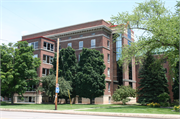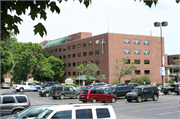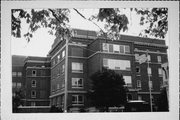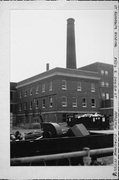Property Record
1506 S ONEIDA ST
Architecture and History Inventory
| Historic Name: | St. Elizabeth Hospital |
|---|---|
| Other Name: | |
| Contributing: | |
| Reference Number: | 38891 |
| Location (Address): | 1506 S ONEIDA ST |
|---|---|
| County: | Outagamie |
| City: | Appleton |
| Township/Village: | |
| Unincorporated Community: | |
| Town: | |
| Range: | |
| Direction: | |
| Section: | |
| Quarter Section: | |
| Quarter/Quarter Section: |
| Year Built: | 1924 |
|---|---|
| Additions: | |
| Survey Date: | 19912015 |
| Historic Use: | hospital/medical clinic |
| Architectural Style: | Late Gothic Revival |
| Structural System: | |
| Wall Material: | Brick |
| Architect: | |
| Other Buildings On Site: | |
| Demolished?: | No |
| Demolished Date: |
| National/State Register Listing Name: | Not listed |
|---|---|
| National Register Listing Date: | |
| State Register Listing Date: |
| Additional Information: | Related building: OU 27/12. 2015: Significant additions have been made to the 1924 I-shaped structure; the most recent of which was completed in 2014-2015. St. Elizabeth Hospital was established in 1899 by the Franciscan Sisters, Daughters of the Sacred Heart of Jesus and Mary and their first facility was a two-story, eleven-room, frame house at 110 Fremont Street. In 1900, eight acres were donated at the existing location where a two-story, brick building (No longer extant) was completed. A larger, three-story brick building and a chapel (no longer extant) followed thereafter. In 1925, the four-story plus basement hospital facility was completed. By the late-1950s, larger additions started to be made. Additions to the facility continue to be made to date; the hospital now offers a total of 352 patient beds. This expansive, multi-storied medical complex reflects construction dates beginning in circa 1925 and continuing to the most recent five-story, 90-bed tower that was completed just this year. The central pmtion of the complex is the 1925, brick, four-story plus raised basement facility-the original entrance of which was oriented to the south. By the late-1950s, a substantial addition had been made to the front of the building (thereby obscuring the building's original entrance), as well as to the rear and to the east. St. Elizabeth Hospital was established in 1899 by the Franciscan Sisters, Daughters of the Sacred Heart of Jesus and Mary and their first facility was a two-story, eleven-room, frame house at 110 Fremont Street. In 1900, eight acres were donated at the existing location where a two-story, brick building (No longer extant) was completed. A larger, three-story brick building and a chapel (no longer extant) followed thereafter. In 1925, the four-story plus basement hospital facility was completed. By the late-1950s, larger additions stmted to be made. Additions to the facility continue to be made to date; the hospital now offers a total of 352 patient beds. St. Elizabeth Hospital has provided health care to area and regional residents for over 100 years. Indeed notable for that fact, the facility has evolved over those years such that the original early 1900 buildings are no longer extant on the property and the substantial 1925 facility has been enveloped in modern additions, such that the 1925 facade is hard to identify. Therefore, because of the substantial additions and alterations made to the medical facility, it is not recommended as potentially eligible under Criterion A: History (Health/Medicine). A DOE is not required. |
|---|---|
| Bibliographic References: | “City of Appleton Timeline,” Available online at www.apl.org/community/hist/timeline, Accessed August 2015; Sanborn Map Company, Sanborn Fire Insurance Map—Appleton, Wis. (New York: Sanborn Map Company, 1911, 1924, 1924 (with updates to 1951); Appleton Historical Society, Images of America: Appleton (Charleston, S.C.: Arcadia Publishing, 2015), 59; Larry Avila, “108M Update at Appleton’s St. Elizabeth Hospital includes 5-story Bed Tower,” Available online at http://archive.postcrescent.com/article/20121011/APC03/310110206/-108M-update-Appleton-s-St-Elizabeth-Hospital-includes-5-story-bed-tower, Accessed August 2015. |
| Wisconsin Architecture and History Inventory, State Historic Preservation Office, Wisconsin Historical Society, Madison, Wisconsin |





